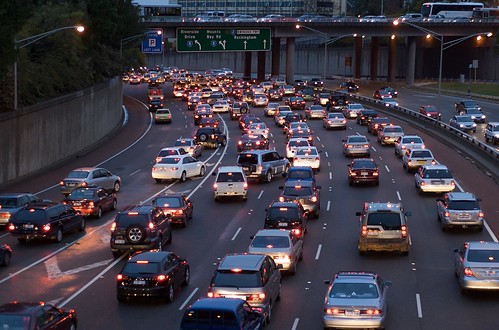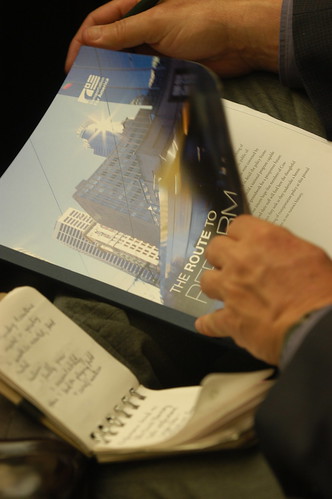(Source: NY Times, USDOT Secretary’s FastLane Blog, AP via Google, Transportation for America)
Late-breaking: The full outline of Rep. Oberstar’s proposed bill is now available on Transportation for America’s website. For those readers brave enough to wade into 90 pages of policy detail, please click here to download a copy of the PDF file. Personally, (after a super-quick glance) I was left scracting my head about the directions of cutting edge programs like Intelligent Transportation Systems. Absolutely no mention of it except under some transit discussion. Also, I did not see any references to how this program will help spur the infrastructure development aspects of electric vehicles (like charging stations, etc)? Possibly dealt through CMAQ or other climate-friendly avenues in ths bill? Would love to know what y’all found out after a careful reading of the outline. Please leave your thoughts in the comments sections below.
With plans for a six-year, $450 billion transportation bill hung up over the question of how to pay for it, the Obama administration said Wednesday that it wanted to put off the thorniest questions for now. Instead, officials proposed essentially extending the existing law for 18 months and finding a short-term way to pay for highway and transit projects.
Rather than face a series of three-month extensions of the law, which has happened in the past, Mr. LaHood said it would be less disruptive for everyone to plan for an year-and-a-half extension now. “We think this is the most realistic approach,” he said. In an interview with Bloomberg, LaHood describes his decision as one to “face reality” instead of “stringing Congress along with three-month or six-month extensions.”
The media reports indicate there is a serious fight happening in the Hill between the Secretary and the folks who spent months working on this bill. The AP report states that at LaHood’s request, Oberstar and key members of the committee met with the transportation secretary Wednesday morning, a half hour before the congressman was scheduled to brief reporters on his bill. LaHood laid out for the surprised lawmakers a plan that seeks to approve money for transportation for another 18 months, eliminating the likelihood that highway and other transportation projects would come to a halt for lack of dollars. The plan would require Congress to approve an estimated $13 billion to $18 billion in stopgap cash.
Rep. John Mica, the senior Republican on the transportation committee, likened LaHood’s presentation of the finance plan to a bomb being dropped on committee members.
“That’s a real slap in the face to a lot of hard work … earth-shattering,” Mica said. “I would have been mortified if this had been done to me under Bush.”
LaHood asked to meet with Oberstar as soon as the administration worked out the details of its plan and went straight to Capitol Hill, said Jill Zuckman, a Transportation Department spokeswoman.
For his part, the Secrtary used his blog to convince the public that he did what he and the Obama administration think is the best approach rather than rushing for a reuathorization bill.
Here are his words: ” Yesterday and today, I briefed members of Congress on the Highway Trust Fund situation and proposed an immediate 18-month highway reauthorization that will replenish the Fund. This is an unusual step, I know. But, with the Fund likely to run out of money by late August, it’s a little too late to worry about business as usual.
Beyond keeping the Highway Trust Fund solvent, an immediate 18-month reauthorization provides Congress the time it needs to fully deliberate the direction of America’s transportation priorities. That’s the kind of thoughtful decision-making America deserves.”
Making a case for his proposal, Sec. LaHood first brought up why we are in this mess and how the Highway Trust Fund went south over the years and months past.

Image Courtesy:USDOT Secretary Ray LaHood's Blog - Fast Lane
As the chart below shows, even in years of relative economic security and gas-price stability, the Highway Trust Fund ended the fiscal year with less money than it started. He pointed to the change in the consumption patterns of the US consumer who was losing sleep over the economic concerns that rocked the country (as well as the entire planet). The prolonged economic insecurity and gas-price volatility, like the one we experienced in 2008, when people bought less gas and Fund’s revenue source dropped off (evident from the chart above). Congress had to kick in an extra $8 billion to the Fund. He warned that the Fund is likely to run out of money once again, and soon. Expenditures will stop; states will be in danger of losing the vital transportation funding they need and expect; projects will shut down; jobs will be lost. That’s the road we’re on right now. Once again, the Highway Trust Fund will need a massive cash infusion.
Can we really go through this every year? Is that really the best this Nation can do?. With that question, he brought the hammer down on Oberstar’s plans. saying “I don’t think so. That’s why I went to the Hill yesterday and why I’ll be there today.” He strengthened his argument for his delayed reuathorization proposal, saying “Time is running out, and the Highway Trust Fund must be made solvent. Then, and only then, can this country get the kind of thorough transportation discussion needed to address our infrastructure investments in a smarter, more focused way, a way that best meets the real demands of the country.”
Representative James L. Oberstar, who is chairman of the Transportation and Infrastructure Committee, still plans to introduce a new bill’s outline today at 2PM (The House T & I Committee Twitter note annoucned that the 11AM briefing is now moved to 2PM), but Democrats said they had not determined how to pay for it. Oberstar had been counting on a looming Oct. 1 deadline — that’s when the current law authorizing federal highway and transit programs expires — to force lawmakers to make tough decisions on how to pay for transportation programs over the next six years.But Oberstar’s spokesman Jim Berard conveyed the Chairman’s displeasure: “The chairman is not too pleased with the administration’s proposal.”
All is not bad for the Secretary. He enjoyed the support of some of his powerful allies in the Senate. Sen. Barbara Boxer (D-CA), chairman of the Environment and Public Works Committee and a key player in the federal transportation re-write, expressed her support for the delayed reauthorization proposal put forward by the Secretary. “I am very pleased that the White House is being proactive in working with the Congress to address the shortfall in the Highway Trust Fund. As we work our way out of this recession, the last thing we want to do is to drastically cut back on necessary transportation priorities. The White House proposal to replenish the Trust Fund until 2011 will keep the recovery and job creation moving forward and give us the necessary time to pass a more comprehensive multi-year transportation authorization bill with stable and reliable funding sources.”
Two congressionally mandated transportation commissions — one in 2008 and one earlier this year — have recommended raising gas taxes as the most practical solution for making up projected declines in revenue over the next several years. The most recent commission also recommended moving to a system that would use GPS technology to tax motorists based on the number of miles they drive as the best long-term revenue solution.
Either step is expected to be politically difficult.
DeFazio said the administration’s plan risks tens of thousand of jobs because contractors need cash commitments beyond 18 months for major, multiyear construction projects.
LaHood acknowledged his plan will be unpopular with some lawmakers and transportation interest groups.
“With the reality of our fiscal environment and the critical demand to address our infrastructure investments in a smarter, more focused approach, we should not rush legislation,” LaHood said in a statement. “We should work together on a full reauthorization (bill) that best meets the demands of the country. The first step is making sure that the Highway Trust Fund is solvent. The next step is addressing our transportation priorities over the long term.”
Late Breaking Update: Transportation for America(T4America), the ever popular website that has been a great source for reauthorization updates just made available a summary of Rep. Obsertar’s proposed bill (shown below, courtesy of T4America)and a 10 page breakdown of the consolidated/terminated programs. A quick analysis by T4America reveals Oberstar proposal terminates or consolidates 75 federal programs from the program and recommends a consolidation into a “performance based framework”. Read the 17p summary and the 10p breakdown of consolidated/terminated programs now on the T4America blog.








